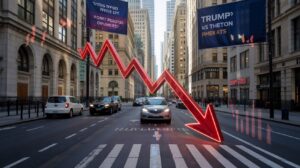Markets Brace for ‘Liberation Day’ as New Tariffs Loom
Markets worldwide are bracing for turbulence as “Liberation Day”—the day new U.S. tariffs take effect—draws closer. Investors, economists, and businesses are on edge as the Biden administration prepares to implement sweeping trade measures that could reshape the global economic landscape. With potential repercussions for stock markets, trade relationships, and economic growth, the financial world is watching closely.
Understanding “Liberation Day” and Its Global Impact
“Liberation Day” refers to the date when the U.S. government enforces new tariffs on imported goods to support domestic industries. While this aims to boost local manufacturing and reduce dependency on foreign imports, it also risks igniting retaliatory measures from other nations, leading to a global trade war.
Key Components of “Liberation Day” Tariffs:
| Factor | Impact |
|---|---|
| Purpose | Protect U.S. industries, reduce trade imbalances |
| Affected Sectors | Technology, automotive, agriculture, consumer goods |
| Expected Market Reaction | Stock market volatility, shift to safe assets |
| Global Response | Possible retaliatory tariffs from trade partners |
Goldman Sachs estimates that these tariffs could cause the S&P 500 to see a -5% return in the next three months, with economic uncertainty looming. The Federal Reserve may have to implement interest rate cuts to counteract negative market effects.
How Markets Are Reacting
Financial markets are already adjusting to the anticipation of new tariffs. Investors are shifting towards safe-haven assets, such as gold, which has reached a record high. Meanwhile, stock markets have shown fluctuations, with major indices experiencing increased volatility.
Market Reaction Overview:
- Stock Volatility: Major indexes such as the S&P 500 have experienced sharp movements.
- Gold Surge: Investors are purchasing more gold, driving up prices.
- Business Uncertainty: Companies dependent on imports are reassessing their pricing and supply chains.
Small businesses that rely on imported materials are among the most affected, as rising costs threaten their ability to remain competitive. Large multinational corporations are also adjusting their operations to mitigate potential losses.
Key Sectors Affected by New Tariffs
Tariffs impact several industries in different ways. Here’s a breakdown of key sectors:
| Industry | Effect of Tariffs |
| Technology | Higher costs for imported semiconductors, leading to pricier electronics |
| Automotive | Increased production costs due to reliance on international suppliers |
| Agriculture | Retaliatory tariffs could hurt U.S. farmers by reducing export demand |
| Consumer Goods | Prices may rise for imported everyday items like clothing and electronics |
Federal Reserve’s Response and Economic Outlook
To combat market instability, Goldman Sachs predicts that the Federal Reserve will introduce three rate cuts in 2025:
- July – Initial cut to ease early trade war tensions.
- September – Adjustment based on market response.
- November – Further reduction if necessary.
Lower interest rates aim to boost economic activity by making borrowing cheaper for businesses and consumers. However, experts warn that rate cuts alone may not be enough if the trade war intensifies.
Strategies for Businesses and Investors
With uncertainty on the rise, businesses and investors should take proactive measures:
- Diversify supply chains: Seek alternative suppliers from tariff-free regions.
- Monitor currency fluctuations: Market instability could lead to unpredictable exchange rate changes.
- Consider defensive investments: Gold, treasury bonds, and recession-proof industries offer stability.
A recent report from The Guardian suggests that this trade dispute could cost the global economy up to $1.4 trillion, affecting financial stability worldwide.
Conclusion: What Lies Ahead?
As “Liberation Day” approaches, businesses and investors must stay prepared for economic shifts. While the government’s goal is to strengthen domestic industries, global repercussions could cause market instability.
With a well-informed strategy, businesses can adapt to trade policy changes and minimize disruptions. As the situation unfolds, monitoring economic indicators and policy responses will be crucial for navigating these challenging times.





